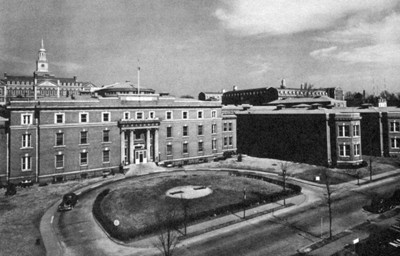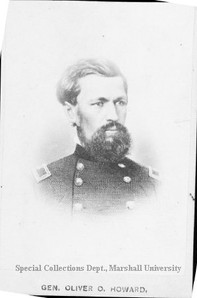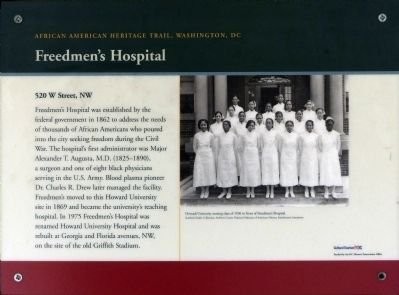Howard University Hospital (Freedmen's Hospital Historical Marker)
Introduction
Text-to-speech Audio
Images
The former Freedman's Hospital building is now the C. B. Powell building and home to the School of Communications

Gen. Oliver Otis Howard. 1865. Namesake of university and second president of school. Photo Courtesy of Marshall University Special Collections.

Freedmen's Hospital Marker - located at the front entrance of Howard University Hospital.

Backstory and Context
Text-to-speech Audio
A short history of Howard University and Howard Medical School
Since 1867, Howard has awarded more than 100,000 degrees in the professions, arts, sciences, and humanities. Howard ranks among the highest producers of the nation's Black professionals in medicine, dentistry, pharmacy, engineering, nursing, architecture, religion, law, music, social work, and education. Carter G. Woodson, "The Father of Black History," was a professor and Dean of the College of Arts and Sciences at Howard.
Howard has grown from a single-frame building in 1867 and evolved to more than 89 acres, including the six-story, 400-bed Howard University Hospital. Since 1974, it has expanded to include a 22-acre School of Law West Campus, a 22-acre School of Divinity East Campus and another three-fifths of an acre facility in northeast Washington and a 108-acre tract of land in Beltsville, Maryland.
Shortly after the end of the Civil War, members of The First Congregational Society of Washington considered establishing a theological seminary for the education of African-American clergymen. Within a few weeks, the project expanded to include a provision for establishing a university. Within two years, the University consisted of the Colleges of Liberal Arts and Medicine. The new institution was named for General Oliver Otis Howard, a Civil War hero, who was both the founder of the University and, at the time, Commissioner of the Freemen's Bureau. Howard later served as President of the university from 1869–74.
Revella Hughes, a talented singer, musician and educator were alumni from Howard. She received her Bachelor's in Music in 1917. Alain Locke, Chair of the Department of Philosophy and first African American Rhodes Scholar, authored The New Negro, which helped to usher in the Harlem Renaissance. Ralph Bunche, the first Nobel Peace Prize winner of African descent, served as chair of the Department of Political Science. Beginning in 1942, Howard University students pioneered the "stool-sitting" technique, which was to play a prominent role in the later civil rights movement. By January 1943, students had begun to organize regular sit-ins and pickets at cigar stores and cafeterias around Washington, D.C. which refused to serve them because of their race. These protests continued until the administration asked the students to stop in the Fall of 1944. Stokely Carmichael, also known as Kwame Toure, a student in the Department of Philosophy and the Howard University School of Divinity coined the term "Black Power" and worked in Lowndes County, Alabama as a voting rights activist. Historian Rayford Logan served as chair of the Department of History E. Franklin Frazier served as chair of the Department of Sociology. Sterling Allen Brown served as chair of the Department of English.
In 1965, President Lyndon B. Johnson delivered a speech to the graduating class at Howard, where he outlined his plans for civil rights legislation and endorsed aggressive affirmative action to combat the effects of years of segregation of Blacks from the nation's economic opportunities. At the time, the Voting Rights bill was still pending in the House of Representatives.
In 1975 the historic Freedman's Hospital closed after 112 years of use as Howard University College of Medicine's primary teaching hospital. Howard University Hospital opened that same year and serves as Howard University College of Medicine's teaching hospital with service to the surrounding community. U.S. Department of Education fundsHoward University and Howard University Hospital.
